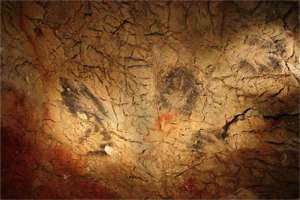NOTE: The illustrations labelled public domain were retrieved from the internet with a search that included the phrase public domain. If any of these are not intended to be public domain I apologize. Please inform me and I will give proper credit or take them down.
Saturday, May 27, 2017
HANDPRINTS MAY RECORD TALLIES OR COUNTS - CONTINUED:
Hand stencil, Maltravieso Cave,
Caceres, Spain, little finger
deliberately painted out,
Paleolithic. Public Domain.
Handprints are a common image in rock art from time immemorial. One interesting phenomenon in handprints in European Palaeolithic cave art is the image of a handprint with one or more fingers only partially represented, or missing altogether. Whereas this used to be interpreted as missing fingers due to Ice Age frostbite, or cultural practice such as chopping off a finger as a mourning ritual, recent authors have suggested that this represents counting systems or tallies.
Handprints, Gargas Cave, France,
Paleolithic. Public domain.
It is
relatively easy to see how handprints with one to five fingers fully extended
or folded/missing could be intended as a count of one to five (https://rockartblog.blogspot.com, May 6, 2017). But what about
handprints with one or more fingers only partially represented? We have five fingers
on each hand so for counting with a base ten (a decimal system) our hands are
ideal, but what about other systems of enumeration such as counting to a base
twelve? Many human cultures have used base twelve numeration (duodecimal)
systems throughout history. Their influences have given us dozen count
quantities, 12 and 24 hour clocks, 12 inches in a foot, 12 signs in the zodiac
and 12 months in a year. (Wikipedia)
Duodecimal hand counting
diagram, from Everett, 2017.
Hand-counting
in a duodecimal system is facilitated by the fact that the four fingers have
three finger bones each (phalanges) and these can be counted with the thumb of
each hand. With this system you can designate a quantity of twelve on each
hand, or up to twenty-four total with both hands. This leads to the proposition that the paleolithic handprints with missing portions of fingers represent numbers in a duodecimal (base twelve) counting system.
In his fascinating book Numbers and the Making of Us: Counting and the Course of Human Cultures, Caleb Everett (2017) explains this, and more in detail, how counting led to civilization and vice versa. So, is this the explanation for the handprints with missing fingers? I do not know but it is possible, what do you think?
NOTE: The illustrations labelled public domain were retrieved from the internet with a search that included the phrase public domain. If any of these are not intended to be public domain I apologize. Please inform me and I will give proper credit or take them down.
NOTE: The illustrations labelled public domain were retrieved from the internet with a search that included the phrase public domain. If any of these are not intended to be public domain I apologize. Please inform me and I will give proper credit or take them down.
REFERENCES:
Everett,
Caleb,
2017 Numbers
and the Making of Us: Counting and the Course of Human Cultures, Harvard
University Press, Cambridge, Mass.
Wikipedia
Labels:
cave art,
counting,
duodecimal,
hand print,
Maltravieso Cave,
paleolithic,
rock art,
Spain,
tally
Subscribe to:
Post Comments (Atom)








No comments:
Post a Comment